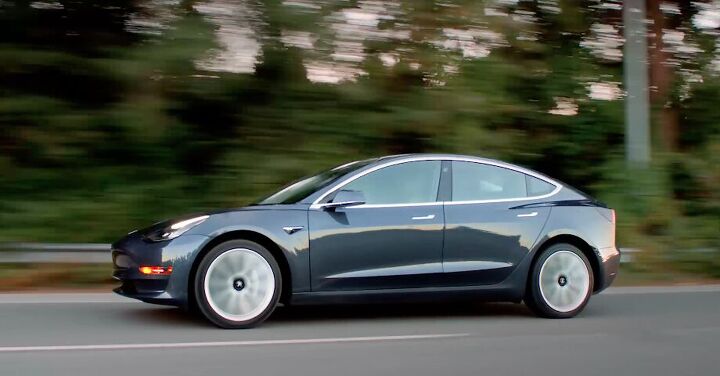Deja Vu: Tesla Gets Into It With the NHTSA - Once Again - After Crash Test Boast

Following the release of crash test results in 2013, Tesla claimed the Model S earned more than five stars on the National Highway Traffic Safety Administration’s ranking scale. Nuh uh, said the NHTSA. There’s only five stars to hand out. No one gets more than that.
Fast-forward five years and the exact same thing is occurring, this time centered around the just-tested Model 3. That sedan, which still isn’t cheap, earned five stars in all NHTSA crash categories. Kudos to Tesla engineers. However, the NHTSA isn’t happy with Tesla’s weekend boast that suggested the Model 3 is the safest car ever tested by the federal agency.
In an October 7th blog post, Tesla claims crash data released by the NHTSA shows the sedan as having “the lowest probability of injury of all cars the safety agency has ever tested” — including its Model S and X. The automaker then goes on to detail the various structural attributes of its product.
After sitting out Columbus Day, the agency fired back with a release of its own. Essentially, the five-star rating is the final word on vehicle safety, the NHTSA said, meaning that several other vehicles, including the Toyota Camry and Ford Mustang, share the same top safety rating as the Model 3.
“The National Highway Traffic Safety Administration’s New Car Assessment Program (NCAP) … conducts a total of three crash tests on new vehicles: one frontal and two side crash tests, as well as a rollover resistance assessment – a driving maneuver test that assesses a vehicle’s susceptibility to tipping up and a measurement of how top-heavy a vehicle is,” the agency wrote.
“Results from these three crash tests and the rollover resistance assessments are weighted and combined into an overall safety rating. A 5-star rating is the highest safety rating a vehicle can achieve. NHTSA does not distinguish safety performance beyond that rating, thus there is no ‘safest’ vehicle among those vehicles achieving 5-star ratings.”
While the Model 3 data is there for anyone to pore over, the NHTSA has a rulebook for automakers who wish to use its ratings for the purposes of PR. Because of this, even though Tesla is on solid ground with its claim of low injury probability, it’s still stepping out of bounds with regard to the NHTSA. There’s the possibility of consequences.
Thus far, Tesla CEO Elon Musk has not responded to the NHTSA’s statement. Perhaps he’s thinking up some cool acronyms.
[Source: Bloomberg] [Image: Tesla]

More by Steph Willems
Latest Car Reviews
Read moreLatest Product Reviews
Read moreRecent Comments
- Formula m For the gas versions I like the Honda CRV. Haven’t driven the hybrids yet.
- SCE to AUX All that lift makes for an easy rollover of your $70k truck.
- SCE to AUX My son cross-shopped the RAV4 and Model Y, then bought the Y. To their surprise, they hated the RAV4.
- SCE to AUX I'm already driving the cheap EV (19 Ioniq EV).$30k MSRP in late 2018, $23k after subsidy at lease (no tax hassle)$549/year insurance$40 in electricity to drive 1000 miles/month66k miles, no range lossAffordable 16" tiresVirtually no maintenance expensesHyundai (for example) has dramatically cut prices on their EVs, so you can get a 361-mile Ioniq 6 in the high 30s right now.But ask me if I'd go to the Subaru brand if one was affordable, and the answer is no.
- David Murilee Martin, These Toyota Vans were absolute garbage. As the labor even basic service cost 400% as much as servicing a VW Vanagon or American minivan. A skilled Toyota tech would take about 2.5 hours just to change the air cleaner. Also they also broke often, as they overheated and warped the engine and boiled the automatic transmission...

































Comments
Join the conversation
Asdf: And yet, doggone it, more people are purchasing these EVs - much to the consternation of those who feel somehow threatened. Tesla/Musk, however, need to chill on the over-the-top tweets and claims; they're only hurting themselves.
Totally off topic, but isn't charge time a matter of physics at this point is battery development? I know of no battery that can take on a complete charge in 5 minutes.